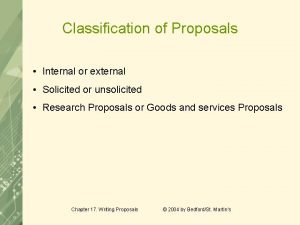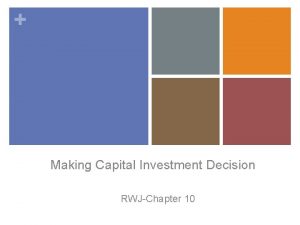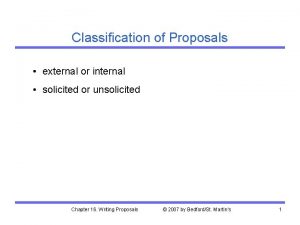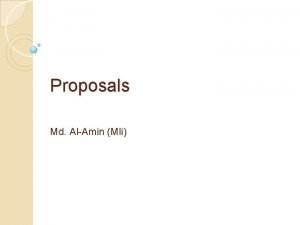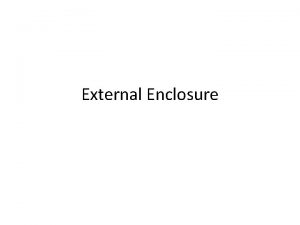Classification of Proposals Internal or external Solicited or















- Slides: 15

Classification of Proposals • Internal or external • Solicited or unsolicited • Research Proposals or Goods and services Proposals Chapter 17. Writing Proposals © 2004 by Bedford/St. Martin's

A Research Proposal Often Leads to Two Other Kinds of Documents: • Progress reports • Completion reports Chapter 17. Writing Proposals © 2004 by Bedford/St. Martin's

To Make a Proposal Persuasive, You Must Clearly Show the Following: • That you understand the need/problem • That you have decided what you plan to do, and that you are able to do it • That you are a professional, and that you are committed to fulfilling your promises Chapter 17. Writing Proposals © 2004 by Bedford/St. Martin's

Four Ways to Demonstrate Your Ability to Carry Out a Project • Credentials and work history • Work schedule • Quality-control measures • Budget Chapter 17. Writing Proposals © 2004 by Bedford/St. Martin's

Three Categories of Resources • Personnel • Facilities • Equipment Chapter 17. Writing Proposals © 2004 by Bedford/St. Martin's

Description of the Need/Problem/Opportunity • What is the problem or opportunity? How is it a problem or opportunity for the audience? • What is the background of the problem or opportunity? • What is the purpose of the proposal? • What are your sources of information? • What is the organization of the proposal? • What are the key terms that will be used in the proposal? Chapter 17. Writing Proposals © 2004 by Bedford/St. Martin's

Proposed Program • What are you going to do to solve the problem? • Be specific. • Include a schedule or timeline. See text p. 451 for an example of a Gantt chart. • Qualifications and Experience • Who is going to carry out the plan? What experience do they have with similar projects? How are they qualified to do the research or carry out the plan? Chapter 17. Writing Proposals © 2004 by Bedford/St. Martin's

Budgets • Direct costs • salaries and fringe benefits of program personnel • travel costs • necessary equipment, materials, and supplies. • Indirect costs or overhead • Allocated to the project based on the notion that it should bear some of the organizational costs. • Can include utilities, office rental, etc. , although not usually detailed. • Usually expressed as a percentage of total budget. Chapter 17. Writing Proposals © 2004 by Bedford/St. Martin's

Conclusion • Summarize and conclude your argument. • Ask for what you want. Chapter 17. Writing Proposals © 2004 by Bedford/St. Martin's

Elements of a Proposal • Letter of Transmittal - 1 • Title page - 1 • Table of Contents – 1 • List of Illustrations - 1 • Summary -. 5 -1 • Statement of need/Description of problem – 1 -1. 5 • Proposed program/research plan - ~1. 5 • Qualifications and experience - ~. 5 • Budget ~. 5 • Conclusion – less than. 5 • References - 1 • Glossary/Appendices - 1 Chapter 17. Writing Proposals © 2004 by Bedford/St. Martin's

Summary • Write it after finishing the body of the proposal. • Should include main points of each section. Chapter 17. Writing Proposals © 2004 by Bedford/St. Martin's

List of Illustrations • Include figure captions worded exactly as they are in text. • Be sure page numbers are accurate. • Use tabs and dot leaders to format (not periods). Chapter 17. Writing Proposals © 2004 by Bedford/St. Martin's

Table of Contents • Include at least the first three level headings. • Entries should be worded exactly as headings in text. • Use tabs and dot leaders to format (not periods). • Don’t include the Table of Contents as an entry. • Be sure page numbers are accurate. Chapter 17. Writing Proposals © 2004 by Bedford/St. Martin's

Title Page • Use a specific title. • Include your name, position, and company name (if the proposal is external). • Include the primary reader’s name, position, and company name (if the proposal is external). • Include the date. • Company logo or slogan is optional. Chapter 17. Writing Proposals © 2004 by Bedford/St. Martin's

Letter of Transmittal (or Cover Letter) • Acknowledge prior contact with the primary reader or his/her company. • Describe the attached proposal in a few sentences. • Include contact information and/or establish additional communication. Chapter 17. Writing Proposals © 2004 by Bedford/St. Martin's
 Internal and external proposal
Internal and external proposal What is an unsolicited trade
What is an unsolicited trade Solicited reports in pharmacovigilance
Solicited reports in pharmacovigilance Pengertian proposal bisnis
Pengertian proposal bisnis Solicited offer
Solicited offer Writing thesis and dissertation proposals
Writing thesis and dissertation proposals Title fly and title page
Title fly and title page Writing and completing reports and proposals
Writing and completing reports and proposals Formal business report
Formal business report Artificial intelligence thesis proposals
Artificial intelligence thesis proposals Nature of fire insurance
Nature of fire insurance Capital investment decision
Capital investment decision Developing effective research proposals
Developing effective research proposals Eclipse computing proposals slow
Eclipse computing proposals slow Delhi muslim proposals
Delhi muslim proposals External-external trips
External-external trips
